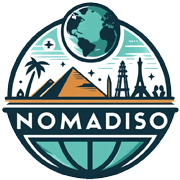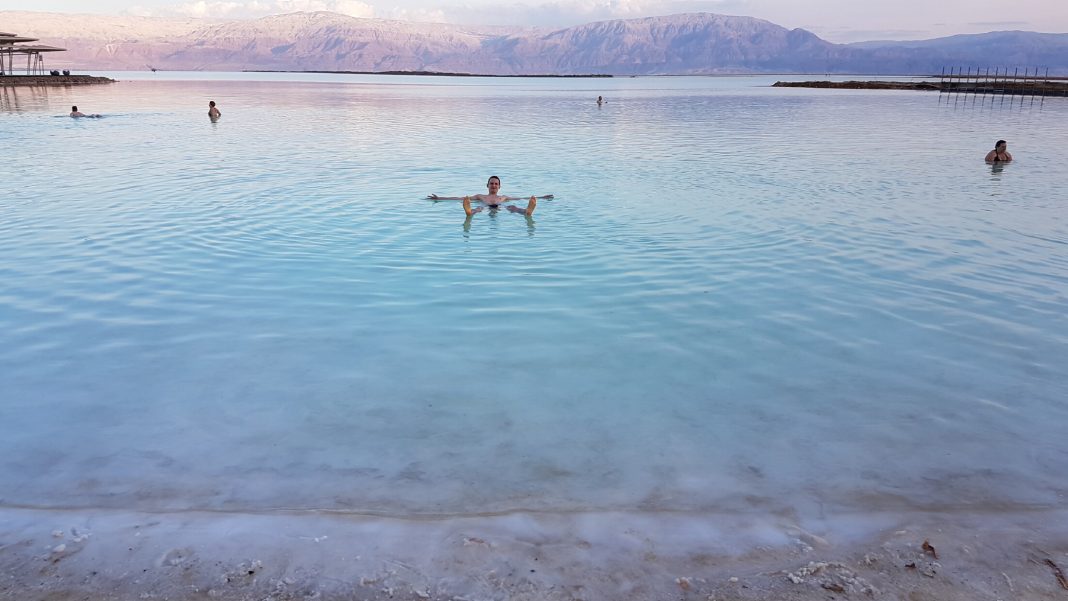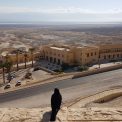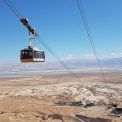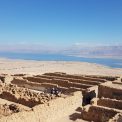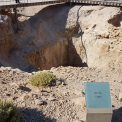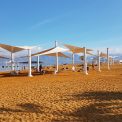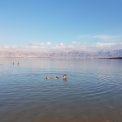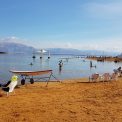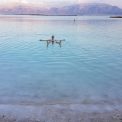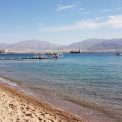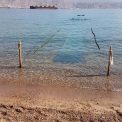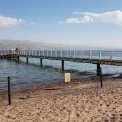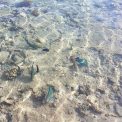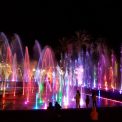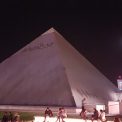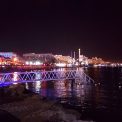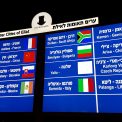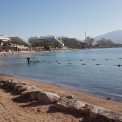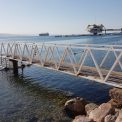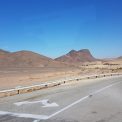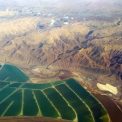November is the month when you can’t swim in the Mediterranean Sea without braving the cold. If you don’t want to opt for expensive exotic locations, Israeli Eilat is perfect for an extended weekend with swimming in the Red Sea. Flights Bratislava – Eilat can be purchased on Ryanair sale from 30€. A trip to Eilat can be combined with the Dead Sea, the massive fortress of Masada, or you can even come here to run a marathon. And by the way, did you know that Piešťany is a twin town of Eilat?
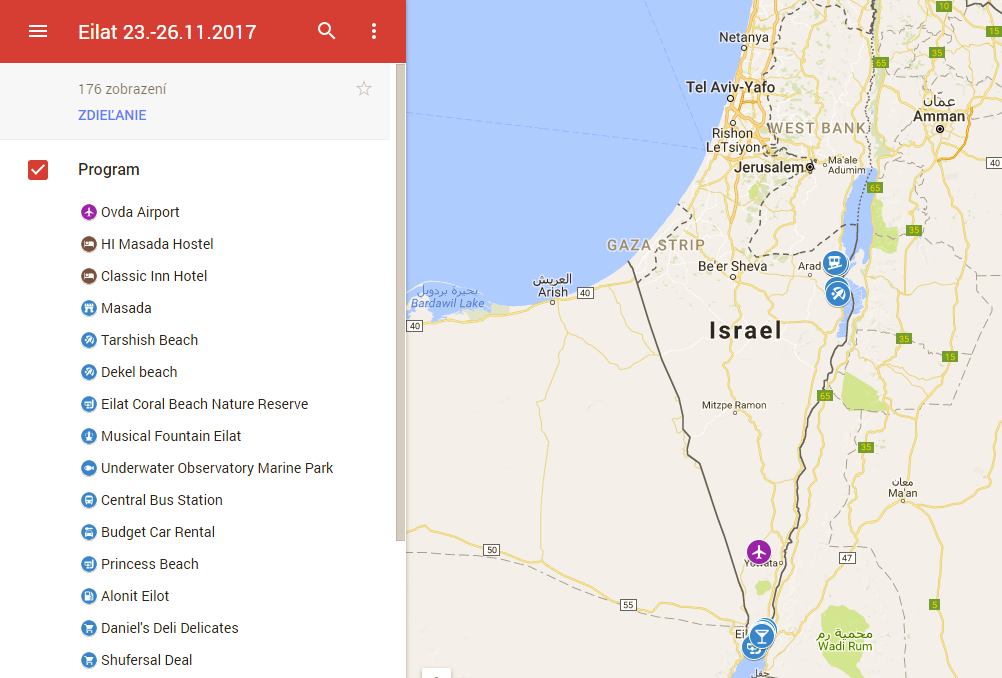
Contents
Day 1 – Eilat and the Red Sea
Day 2 – Masada and the Dead Sea
Day 3 – Dekel Beach, Coral Beach and the singing fountain
Day 4 – City Tarshish Beach
Day 1 – Eilat and the Red Sea
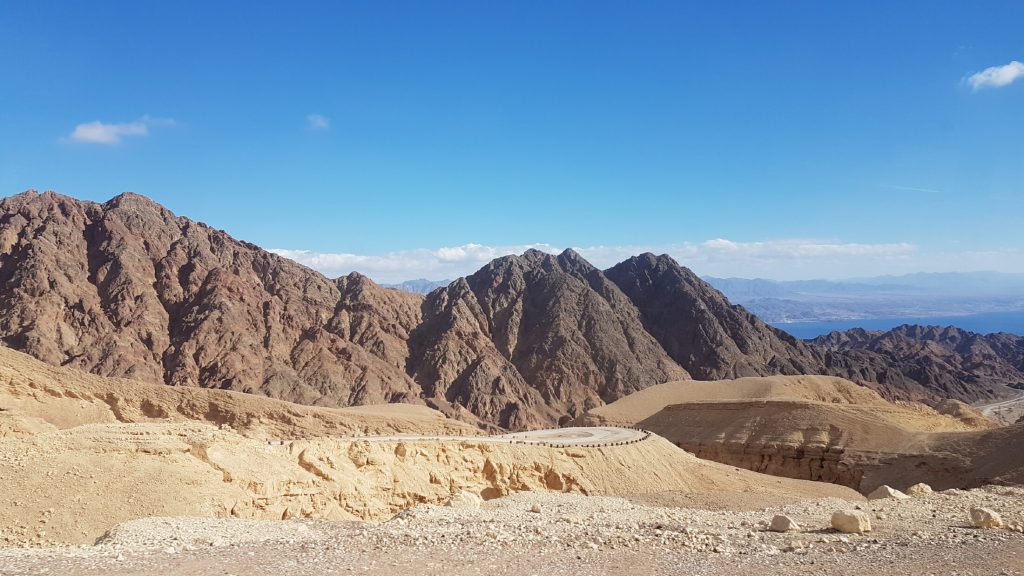
The regular route Bratislava – Eilat (Ovda) operates on Thursdays and Sundays at 7:45 from Bratislava. Ovda Airport is a former military airport located approximately 60 km from Eilat. Bus transportation is provided by the public transport company Egged or by the private operator Eilat Shuttle, which is a few euros more expensive.
UPDATE: New Ramon Airport – from April 2, 2019, you will arrive at the new Ramon Airport, which is only 20 km from Eilat. You can rent a car here or take buses 30 or 50.
We get off at the Central Bus Station stop, from where it is about a 5-minute walk to the individual car rental offices. We booked our car through the Ryanair car hire website, where we found that Budget was the best company. Although they require an international driver’s license in the terms and conditions, we can confirm that it is not necessary. And be aware, car rental offices are closed on Friday afternoons and Saturdays.
After renting a car, we head to Princess Beach. Eilat is dotted with roundabouts, so if you forget to turn, you can quickly turn around. Many of them have creative designs such as statues with musicians, a yellow submarine, or a pyramid. The beach is almost by the Egyptian border, and we were able to park under the Colonia restaurant.
TIP: There is free WiFi throughout Eilat, which even reaches some beaches.
The beach is rocky, and the recommended entry into the water is via two footbridges. If you have water shoes, you can also enter directly through the designated entrance. If you want to snorkel, the largest group of fish is found under the footbridges.
TIP: In November, the sun sets around 5 PM, but since all the beaches are in a valley, the sun sets behind the hills much earlier.

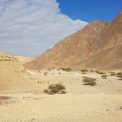
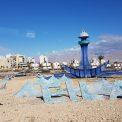
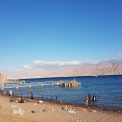
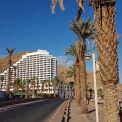 In the evening after sunset, we have a transfer planned to the fortress Masada. When leaving Eilat, it’s worth stopping at the large supermarket Shufersal Deal. Again, on Friday evening and Saturday, it is closed. Prices in restaurants are 2 to 3 times higher compared to Slovak prices. For example, a beer in a pub costs €7, a large pizza €22, and a water pipe €11.
In the evening after sunset, we have a transfer planned to the fortress Masada. When leaving Eilat, it’s worth stopping at the large supermarket Shufersal Deal. Again, on Friday evening and Saturday, it is closed. Prices in restaurants are 2 to 3 times higher compared to Slovak prices. For example, a beer in a pub costs €7, a large pizza €22, and a water pipe €11.
The road to Masada runs along the Dead Sea. The official speed limit is 90 km/h, but cars usually drive at 120 km/h, so we adapted as well. After all, it’s over 200 km, and if you want to make it in two hours, you need to go faster. Occasionally, you will encounter a good speed bump.
Accommodation HI Masada Hostel is the only accommodation near Masada. The hostel’s name is somewhat misleading in this case. It is a sandy-colored hotel styled like a fortress with a pool and a view of the Dead Sea. Although the pool was closed during our visit (supposedly only until 4.11.), you can still enjoy the evening wandering around the stairs and terraces.
Day 2 – Masada and the Dead Sea
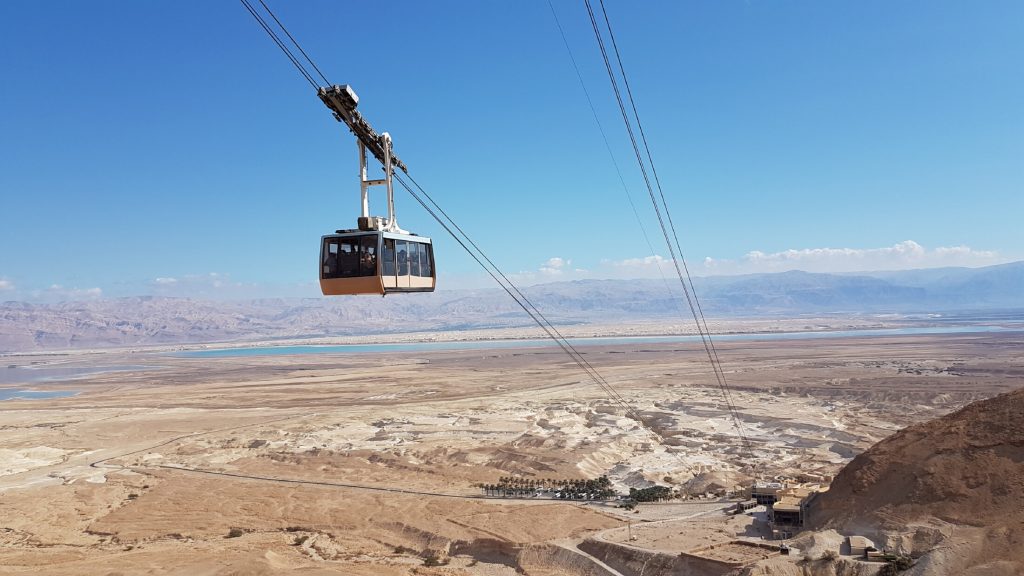
Breakfast at Masada Hostel is quite an experience. We haven’t seen so many varieties of cold and hot dishes, vegetables, fish, fruits, and sweets in a long time. Check out is at 10:00, but you can leave your car in the parking lot longer. You can ascend to Masada either on foot via the “snake path” or by cable car. The elevation is approximately 350 meters. We chose to go up by cable car and descend on foot. For such a ticket, you pay 56 ILS; if you only want admission, it’s 28 ILS. Credit cards are accepted everywhere.
Masada is an ancient fortress built by Herod the Great in the 1st century BCE. It was the last stronghold of the Jewish rebels against the Romans. Three Roman camps are still marked in the form of rectangles. Since 2001, it has been listed as a UNESCO World Heritage Site. Its water system consisted of two aqueducts that ended in carved cisterns of size 40,000 m³.3. The water was transported to the upper cisterns within the fortress by animal caravans.
Upon entering the fortress, you find yourself on a huge plateau. You walk along the walls, ruins, and towers with a magnificent view of the Dead Sea. On the northern side lies Herod’s three-tier palace. A staircase leads to the preserved ruins, providing one of the greatest experiences. Overall, we can say we have never seen anything more gigantic in our lives.
The entire fortress, including the descent, took us about 4 hours. The cable car, or the snake path, represents the eastern entrance, but you can also access the fortress through the western entrance from the city of Arad. The snake path is definitely more interesting. You don’t have to worry about descending in sneakers or sandals, as the path is paved and has plenty of steps.
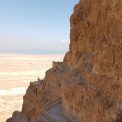

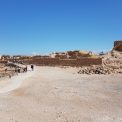
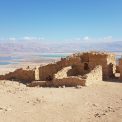
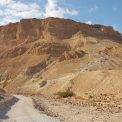 In the afternoon, we visited the Dead Sea. The water’s salinity reaches 30-35%, which is 10 times higher compared to seawater. According to ancient legends, the ruins of Sodom and Gomorrah lie at the bottom of the lake. Despite the numerous beaches around the Dead Sea, the reality is quite the opposite. In the north, there is the open Kalia Beach, which we visited during our first visit to Israel – Tel Aviv. Furthermore, Ein Gedi Beach was closed during our visit. Heading south, there are also Ein Bokek Beach and Neve Zohar Beach, which were our focus this time.
In the afternoon, we visited the Dead Sea. The water’s salinity reaches 30-35%, which is 10 times higher compared to seawater. According to ancient legends, the ruins of Sodom and Gomorrah lie at the bottom of the lake. Despite the numerous beaches around the Dead Sea, the reality is quite the opposite. In the north, there is the open Kalia Beach, which we visited during our first visit to Israel – Tel Aviv. Furthermore, Ein Gedi Beach was closed during our visit. Heading south, there are also Ein Bokek Beach and Neve Zohar Beach, which were our focus this time.
Ein Bokek is a tourist area with luxurious hotels. The Ein Bokek Beach has reddish-brown sand with a gradual entry into the sea. It provides a delightful floating sensation, especially for first-timers. It is recommended to spend 15 minutes in the water, although staying longer is not necessary. The disadvantage of these southern beaches compared to the northern ones is the absence of mud at the bottom for therapeutic purposes. You can only buy the mud, as we saw some people with containers. Interestingly, the lowest-lying ATM in the world can be found here, given that the Dead Sea is over 420m below sea level.Neve Zohar Beach is a few minutes south along the Dead Sea shore. The beach was unique with the amount of salt washed up on the shore and the salty bottom. We cannot say if it is still like that, but it was quite an experience to walk on such a smooth bottom. In the distance in the sea, you can spot an abandoned tree. A young group with a drone even filmed it up close, and with the salt, it looked perfect.
Day 3 – Dekel Beach, Coral Beach and the singing fountain
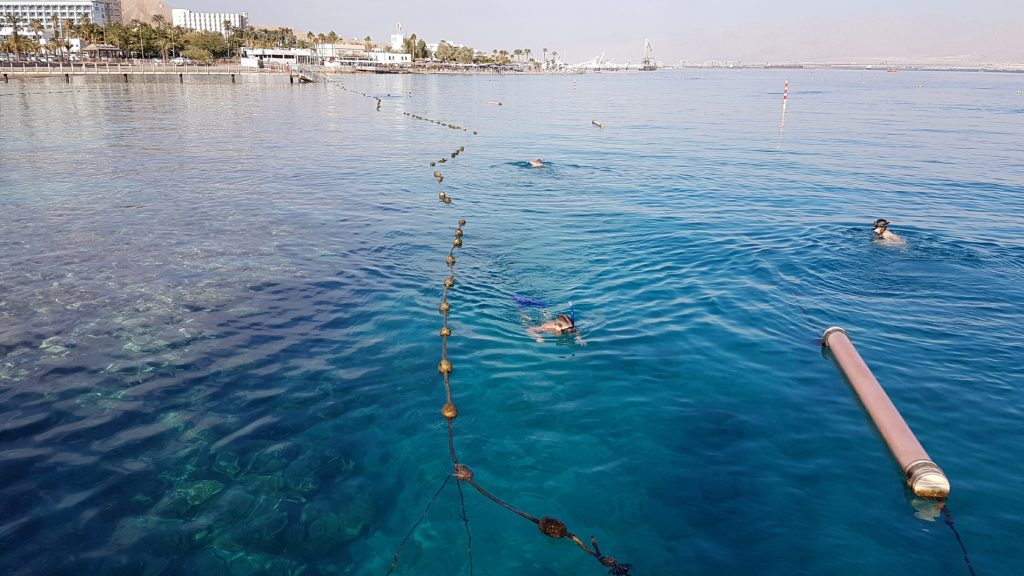
In Eilat, there are several city beaches. We wanted to focus mainly on the non-urban ones because we believed that the closer to the Egyptian border, the more fish and corals there would be. As we found out on the last day, this is not entirely true because even directly in Eilat, we saw beautiful corals and vibrant underwater life.
The first more distant beach from the city is Dekel Beach. It is a newer enclosed area with a guard at the entrance who also checked our backpacks. In the area, there is a bar, the possibility of renting sunbeds, large sun shelters, and rubber mats at the water entrances so that you don’t accidentally step on a stone. Near the shore, we didn’t see much, but when you swim further, you come across beautiful corals. We saw, for example, greenish-yellow salad corals or black lionfish, which looks like a porcupine. But we also came across translucent jellyfish with orange insides, which were quite hard to see.
Coral Beach is a natural reserve and national park in the Red Sea. The coast is covered by the most northern over 1km long coral reef. The entrance fee to the area is 35 ILS, but we definitely did not regret it. The beach is sandy, and you enter the water through two bridges. Everything else is fenced off to protect the corals. The entire coral reef strip is also fenced off for snorkeling.
It is a bit limiting that you have fish at arm’s length, but there were also places where you could get closer. There are plenty of fish here. Among the less typical ones, I can mention, for example, clown coris or rusty parrotfish. It may not be a rule, but we saw the best pieces towards Eilat. There are tubes in the water that you can hold onto if you want to rest. We also meet many divers who dive near the rocks further from the shore.
If you have enough time, you can visit the largest aquarium in the Middle East Coral World Underwater Observatory for 99 ILS, or for 95 ILS online. Every hour, you can see the feeding of various marine creatures.
In the evening, we plan to visit the city and the singing fountain Musical Fountain Eilat. It is located in a park near the beginning of the airport, and the magic of this place is enhanced by a pyramid-shaped cinema, with the moon visible above it.
TIP: The fountain operates on Tuesdays, Thursdays, Fridays, and Saturdays at two times: 19:30 and 20:30
Eilat has the main airport right in the city center, so you can enjoy each plane up close. Mostly domestic flights from Tel Aviv and Haifa land here, with only a few international flights capable of landing on the shorter Eilat runway. In 2018, they plan to open the new international airport, Ramon, which will replace both Eilat and Ovda.
Day 4 – City Tarshish Beach
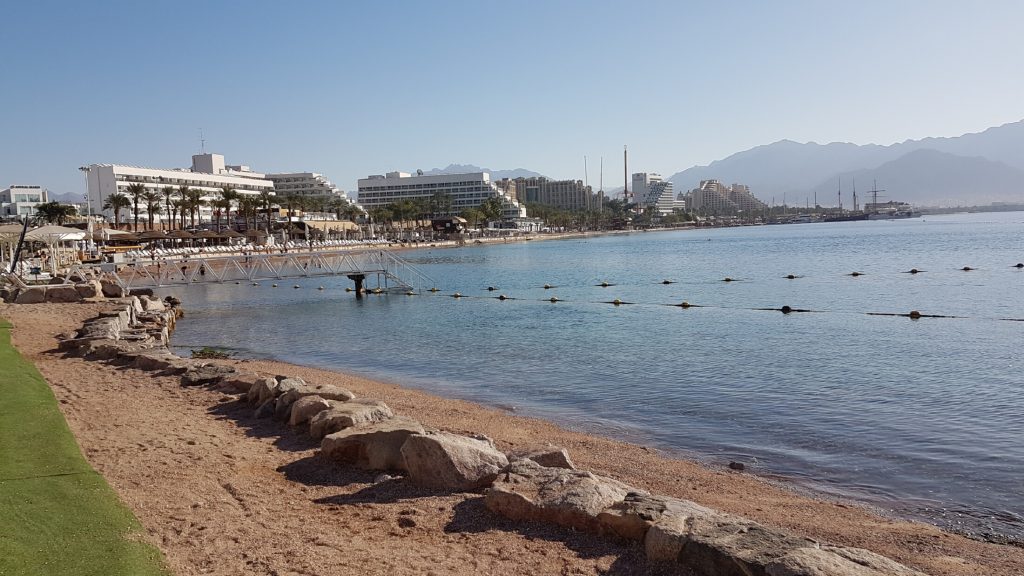
On the last day, there isn’t much time. We check out, pack our things into the car, and head to the nearest city beach Tarshish BeachParking at Mall Hayam shopping center is available for 5 ILS per hour. Despite low expectations, this beach pleasantly surprised us. Beautiful visibility, greenish-yellow corals, and plenty of fish.
Allow 5 minutes to transfer to the main bus station from Budget car rental. If you have purchased Egged tickets online, you need to exchange them at the ticket window inside the station. The advantage of online booking is that you have a guaranteed seat on a specific bus, in our case at 9:20.
TIP: Arrive at Ovda Airport at least 3 hours before your departure, as security checks from our experience take at least an hour and a half.
There are a total of five checks:
- Interview with questions about your relationship, where you stayed in Eilat, who packed your luggage, etc.
- Baggage scan for radioactivity
- Personal search and baggage inspection
- Standard baggage and metal scanner as we are used to
- Passport control
There is a water fountain after the checks. Our departure to Bratislava is at 13:05.
